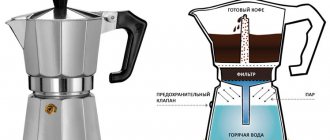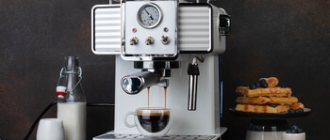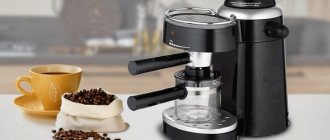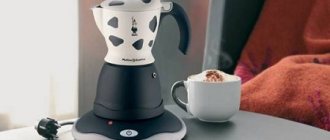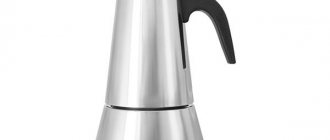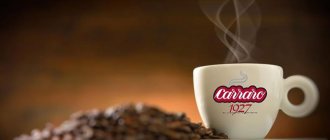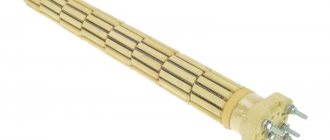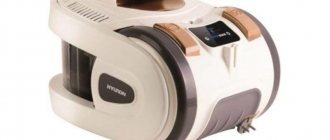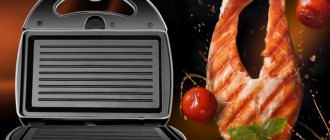Variety
There are mainly two types of coffee trees cultivated on plantations: Coffea arabica and Coffea robusta. Arabica gives coffee an oily texture, rich aroma, sourness and sweetness. Robusta adds bitterness, but makes the drink thicker and saturates it with caffeine. These varieties are characterized by a pronounced invigorating effect.
Arabica coffee accounts for 70% of world production; many single varieties of this species can be found on sale. Robusta is added to mixtures to increase the strength, give a thick consistency and obtain a fluffy foam. Blends (mixtures) presented on store shelves, as a rule, contain up to 20% robusta. Manufacturers indicate information about the composition on the packaging, so when choosing, you can partially predict the final taste of the drink.
Operating principle of a drip coffee maker
Water from the boiler goes to the heater combined with the stove. When heated, it rises in the form of a water-steam mixture through the tube and condenses, then flows in drops into the compartment with coffee, passing through a layer of coffee under natural pressure and passing through the filter, flowing into the compartment of the finished drink. After the water in the boiler runs out, the heater continues to heat the finished drink.
Which ground coffee should I choose for my drip coffee maker?
The quality of the drink that comes out of your drip coffee maker depends on the type and quantity of coffee, the grind of the coffee you use, and the amount of water.
Freshly roasted coffee that is properly ground will certainly produce good coffee. That's why some manufacturers produce drip coffee makers with a built-in coffee grinder.
Finely ground coffee, more coffee and less time of pouring water gives a stronger and richer drink. The coarser the grind, less coffee and more pouring of water, the waterier the coffee.
All water poured into the boiler flows through the layer of coffee, so the amount of water must be commensurate with the number of cups of coffee received. Using the same amount of the same coffee and the same volume of water produces the same flavor of coffee. Therefore, it is difficult to influence the taste. And we must not forget that a drip coffee maker allows you to prepare only Americano coffee. Cappuccino, latte, iced glass, espresso, etc. cannot be obtained from a drip coffee maker.
When buying ground coffee, you should choose only those intended for filter coffee or for drip coffee makers with the appropriate label. For drip coffee makers, experts recommend medium or coarse grinding of coffee.
Speed of water flow through a layer of coffee
The quality of coffee is also affected by the rate of penetration of water droplets through the layer of ground coffee. The faster the water passes, the less strong the coffee will be. Thus, a coffee maker with minimal power will brew coffee with a rich taste. If the coffee maker has an adjustable speed of hot water supply to the coffee powder, then it is possible to prepare different coffee in terms of richness and strength. The concentration of the drink depends on the speed of preparation. Spilling water at a minimum speed, that is, controlling the strength, allows you to brew coffee much better.
You should also use high quality packaged water. However, there are models that contain both a coffee filter and a water filter. A water filter is relevant for those who pour water from the tap. In this case, the filter protects the device from scale, extending the life of the coffee maker.
Housing material
The body of most drip coffee makers is made of plastic. Expensive models are made of plastic with finishing, with stainless steel accents, or part of the body is hidden under metal sheets. However, such an expensive case does not make any contribution to the taste and does not affect the quality of the coffee.
Water tank
The water container should be easy to clean, removable and cleanable, and have enough capacity to brew the desired amount of coffee. Water is filled from above and it should be possible to add water. By adjusting the water portion, you can set the amount of drink that the coffee maker prepares at one time.
All drip coffee makers pass all the water through the coffee compartment, so you should measure the volume of water based on the number of consumers, and not completely fill the reservoir. Initially, you should calculate the number of people who will drink coffee at the same time.
Manufacturers choose the power of the coffee maker based on the maximum volume of water.
Coffee maker heater power
The heater power setting affects the speed of coffee preparation. Drip coffee makers produce a power of less than 1 kW. The average power of a regular coffee maker is 1kW +/- 100W. Not so much power is required to heat water. The device starts working when the heater reaches the required temperature. For a drip coffee maker with a coffee flask volume of less than one liter, a power of 400-700 W is considered sufficient. However, the speed of heating water does not provide high quality coffee. The faster the water flows through the layer of coffee, the worse the quality and watery coffee.
For drip coffee machines, two types of heaters are used - a boiler and a thermoblock. A boiler is a metal container with a heating element. It takes longer to heat the water. And in the thermoblock, the liquid heats up as it passes through the heat exchanger. Consequently, the thermoblock heats the water much faster. It is much more difficult to control the cleanliness of the thermoblock; decalcification is required more often, which is a disadvantage of this type of heater.
Automatic decalcification of coffee makers
Modern coffee makers are equipped with a cleaning indicator. A function called automatic decalcification allows you to descale your coffee machine. Decalcification is a mandatory option when using hard water. Otherwise, scale will accumulate on the heating element, which can lead to failure of the device. Coffee makers without a decalcification function must be cleaned regularly by hand.
Anti-drip system
Drip coffee makers are equipped with an anti-drip system. This system blocks the flow of drink when the flask, coffee pot or ready-to-coffee jug is removed. It's actually a valve. The lid of the coffee container presses on it. This system makes it possible not to wait until the end of preparation of the entire portion of coffee, but after two minutes to pour the very first cup. The remaining drink accumulates inside the device and enters the valve.
A very convenient feature for those who like to enjoy excellent coffee in the office. Since you have to prepare a drink for many people at the same time, you don’t need to wait until the entire volume of coffee is completely prepared. It is enough to wait two or three minutes from the start of preparation and the first mugs can be safely served. Without this function, you would have to wait at least 10-15 minutes and pour the finished drink for everyone at the same time. In addition, this function is convenient because drops from the tap are contained and do not splash the entire kitchen. Usually high-quality coffee makers are equipped with this system, it is sometimes called a “drop stop”.
Capacity of drip coffee makers
This is a parameter indicating the number of servings that the coffee maker prepares at a time. The volume of the jug corresponds to the volume of the water tank. Both containers usually have measuring marks on them.
Most drip coffee makers are designed for 1-1.5 liters. Models above this volume are chosen for offices.
The Specialty Coffee Association of America (SCAA) recommends using 90-120 grams of coffee per 1.9 liters of water in a drip coffee maker. That is, the weight of water is approximately 15 times the weight of coffee.
Many drip coffee makers are not capable of brewing the maximum portion. Because a standard jug is designed to hold about 1200 ml, that is, you need to pour about 80 g of ground coffee into it. This amount of coffee will not fit into the filter and the water will pass through the coffee layer too slowly. In addition, coffee grounds can overflow the edge of the filter, clogging the anti-drip system.
Therefore, the volume must be chosen with calculation. For example, for a family of two, it is not advisable to choose a coffee maker that can produce 2 liters of coffee per cycle. There is no need to chase the maximum volume, since coffee takes longer to prepare in them; you also need to take into account that the larger the tank volume, the more expensive the coffee maker.
The jug has a spout and a plastic lid. Try not to break the coffee jug. It will not be possible to use a jug from another model or another similar container. This will be prevented by the presence of a special anti-drip system. This means you will have to purchase a new coffee maker.
Filter material
In drip coffee makers, the filter is used to prevent ground coffee from getting into the coffee. The coffee maker is equipped with a reusable or disposable filter. The reusable filter must be washed after each use of the coffee maker. An alternative to a reusable filter is to use disposable paper filters, which after use can be taken out and thrown away along with the coffee grounds.
Filters can be replaced. For example, you can abandon reusable ones and switch to disposable paper ones.
Filters are made of metal, nylon, or “gold”, that is, it is the same nylon filter coated with titanium. You will also have to wash it; in operation, it is no different from a regular nylon filter, and its cost is an order of magnitude higher. Therefore, it is believed that the “golden” filter is nothing more than a marketing ploy by manufacturers.
Experts cannot come to a consensus on which ones are preferable. In inexpensive models there are almost always paper ones, and in expensive ones - metal, nylon (with or without coating). At the same time, expensive coffee makers have the option of using disposable filters.
Automatic shutdown
Drip coffee makers, having spilled the entire volume of water from the reservoir, switch to heating mode for the resulting coffee on average for about an hour. Therefore, you will have to resort to manual shutdown in case of incomplete consumption of all the water.
On timer
An auxiliary function for setting a specific coffee preparation time. A very convenient feature for busy business people. Who would like to receive ready-made coffee on the table when they come home? To do this, you need to pour water in advance, add ground grains and set the time. At the appointed time, the coffee maker will automatically turn on and prepare coffee. Typically, such models also provide an “auto-shut-off” function, that is, if the device is not used for several minutes, the power supply automatically turns off.
Automatic heating plate
The function is to maintain a high temperature of the coffee in the jug. Heating continues after the coffee has finished brewing. Top brands of drip coffee makers are equipped with this function. The heating plate is located under the flask with coffee and is supposed to maintain the temperature for some time. This time can either be set manually or programmed by the manufacturer. A device with an auto-shut-off function turns off the auto-heating plate at the same time.
Adjusting the coffee temperature
It varies the taste of the drink. So, lower temperatures make the taste sour, and higher temperatures give a slight bitterness.
More expensive drip coffee makers provide a wide range of options. The most useful features are the water dosing function and the built-in coffee grinder. Freshly ground beans make the best drink. And if you only drink filtered coffee, then it’s a logical idea to combine a coffee grinder and coffee maker in one device and thus save space on the kitchen counter.
There are few household drip coffee makers on the market that come with a built-in coffee grinder. These are automatic drip coffee makers that do everything with one touch and come with timers to brew your coffee at a specific time.
The rest of the drip coffee makers require you to prepare the ground coffee yourself and put it in the filter. These drip coffee makers differ in design and quality of materials, brand, and few additional functions.
The choice can be made based on appearance and price. The volume, type of filter used, the presence of additional functions, that is, auto-shutdown and timer are also objective parameters.
Cheap models, at a price, can present a surprise with quick breakdown or a plastic taste in the finished drink. Even with expensive models, the smell of plastic can wash out during the first few preparations. Therefore, even for the most expensive coffee maker you need to do a couple of idle preparations.
But no one will give a 100% guarantee of quality. Products may differ in quality from batch to batch.
Roasting
During temperature treatment, the chemical composition of grains changes, up to 30% of new compounds are formed in them, which affect the taste. The amount of organic acids decreases, substances appear that give coffee chocolate, caramel and nutty shades. Light roasting produces herbaceous and acidic tones, while strong roasting makes the coffee oily and introduces characteristic bitter notes.
Roast selection:
- weak – weak morning coffee with milk;
- medium - American;
- strong – espresso, ristretto.
The universal roast for most coffee makers is medium.
You can experiment with heavily roasted grains in a carob and in a Turk - with this method of cooking, the taste will reveal itself brighter.
Device of drip coffee makers
The design of drip coffee makers is the same and consists of the following basic elements:
- Fixed cold water tank
- Reservoir (boiler) for heating water
- Heating unit
- Removable or fixed funnel and self-contained filter for ground coffee.
- Flask, jug or coffee pot for ready-made coffee. This role is sometimes played by ordinary coffee cups.
However, different brands produce different devices that differ in their characteristics. They may differ in design, power, volume, material.
Additional functions added to drip coffee makers : timer, delayed start, electronic control. Modern models also have various combinations of automatic shut-off, cleaning indicator, programming, strength control, LED display, cleaning indicator, water filter, permanent coffee filter , adjustable brew size, brew mode for iced coffee, built-in milk frother, thermal carafe to keep your coffee warm for hours.
Grinding
Grinding coffee for a coffee maker is one of the decisive factors influencing the final taste of the drink. During heat treatment, the substances contained in the beans are extracted: caffeine, essential oils and organic compounds. The smaller the particles, the faster this process takes place.
The choice of grind depends on the cooking method:
- medium-coarse – drip coffee makers;
- medium – carob and geyser models, French press;
- thin and ultra-thin - Turk.
Correctly adjusted grinding is especially important for the quality of espresso, which is prepared in coffee makers with a holder (carob).
What is a drip coffee maker
Drip coffee makers are the simplest devices with a long history, designed to prepare only one type of coffee drink - Americano or filter coffee. And they are the most affordable coffee maker on the market.
In the later period, coffee makers began to take on more standardized forms, commensurate with the large increase in scale of production needed to meet post-war consumer demand.
Plastics and composite materials began to replace metal, especially with the introduction of new electric drip coffee makers in the 1970s.
In the 1990s, consumer demand for more attractive appliances to complement expensive modern kitchens led to a new wave of coffee makers in a wider range of available colors and styles.
Carob coffee makers
In this type of machine, espresso is brewed using steam, which passes through a coffee tablet under high pressure.
Indicators of proper preparation of the drink:
- uniform flow of coffee into the cup;
- uniform foam color without black and white spots;
- moderately moist and dense coffee tablet after preparation.
You can determine the appropriate degree of grinding experimentally - water flows more intensively through too large fractions, and the drink turns out to be too liquid, and the tablet acquires a loose structure after preparation. If the situation is exactly the opposite and the particles are too small, the liquid will have difficulty passing through the holder, leaking out in drops.
There are many varieties of machine coffee available in the market. The leaders are Lavazza, Molinari, Illy and Paulig. The best espresso comes from freshly ground coffee, so give preference to bean varieties.
It is not recommended to use varieties with aromatic additives in carob coffee makers. The substances leave a strong odor in the coffee maker. Cheap products may have chemical components added that destroy the elements of the device.
Grind Selection
Well-prepared filter coffee has no grounds or suspended particles, so you can drink it to the bottom. To achieve purity of the drink, you need to use the correct grind.
Coarsely ground coffee is better for drip coffee makers than finely ground coffee. You need to look for the corresponding inscription or picture on the pack. The device prepares a full bowl in 6-8 minutes. During this time, large particles have time to heat up sufficiently and brew. The coffee turns out rich, moderately strong, without suspension or excess bitterness. Ideal particle size, like fine crystalline sugar. Lovers of a strong drink can choose a slightly finer grind. The larger the particles, the lighter the taste. The coarsest grind (like for a French press or Chemex) is not suitable: it will brew weakly.
A pronounced smell of burnt beans and an unpleasant bitter taste appear if the coffee powder is overheated. This happens if fine or even fine grinding is used. Water hardly passes through the thickness of the coffee powder, washing out as much as possible from it. Cooking time increases. The drink turns out cloudy, with suspension. In addition, it contains higher caffeine content.
- This is interesting: Is caffeine a drug?
Drip coffee makers use disposable paper filters or reusable mesh filters. Coarser filters (metal or nylon) only retain large grains. Paper filters can also catch small particles, but finely ground coffee will still turn out bitter.
Modern equipment from the middle and high price categories may have an additional option - grinding the grains immediately before cooking. Such units provide the required fraction, so you don’t have to look for the “correct” ground coffee for a drip coffee maker, but buy grain and entrust its grinding to the equipment.
Drip coffee makers
The devices have a simple design. There is a heating element at the bottom of drip coffee makers. The top container contains a filter where coffee powder is placed. The water is heated, passes through the ground grains and enters a transparent flask. Such models are designed for preparing Americano; it is impossible to get real Italian espresso in them.
For drip models, only medium-coarse grinding is suitable. The filter holds large particles well, but smaller fractions can leak into the flask and ruin the structure of the drink. In order not to make a mistake when choosing ground coffee, pay attention to the labeling - the packs should have an image or inscription indicating that the product is intended for drip coffee makers.
The best taste comes from grains with pronounced acidity. Single varieties and mixtures of various types of Arabica from Guatemala, Dominican Republic and Costa Rica are suitable. For an invigorating effect, choose coffee with up to 10% robusta added. If the percentage is higher, the drink may not be as aromatic and have a pronounced bitterness. A wide range of products for drip coffee makers is offered by the Finnish company Paulig.
How does a drip coffee maker work?
It's very easy to brew coffee in it. If you have never done this, you can watch the video instructions.
- Fill the container with water.
- We place the grains in the filter of the device. We calculate how much coffee needs to be poured into a drip coffee maker depending on the volume of the tank. Standard proportion: 60 g of ground beans per liter of water.
Important! You can choose the strength of the finished drink yourself by varying the volume of liquid and the number of grains.
Drip coffee maker diagram
- Close the lid of the coffee maker and turn it on. Actually, this is where our active steps in making coffee end: then we just have to wait a little for the process to complete.
- When heated, the water rushes up into the filter with ground beans and brews coffee.
- Now the finished drink trickles down drop by drop straight into the coffee pot. As soon as the container runs out of liquid, the device automatically switches to heating mode so that the drink does not cool down.
Geyser coffee makers
The device is a coffee pot with a screw-on bottom container that is filled with water. The principle of operation is reminiscent of a natural phenomenon - during boiling, steam is formed, which pushes water upward. The liquid passes through a filter filled with ground coffee.
The degree of grinding will be of great importance for the quality of the drink. An ultra-fine filter will not work here - small particles clog the filter and prevent the free passage of water. Fractions that are too large do not have time to release most of the substances; as a result, the drink may turn out to be liquid and not aromatic.
For geyser coffee makers, medium grind coffee is suitable, with a consistency reminiscent of semolina. If you grind your own coffee, keep an eye on the time. The operating time of the coffee grinder is no more than 20 seconds. Subsequently, the knives in most models begin to heat up, which leads to oxidation of the product and the appearance of bitterness.
Coffee for the coffee maker
To buy good ground coffee for your coffee maker, you need to know the selection rules. The preparation process, degree of grinding and roasting depend on the type and operating principle of the coffee maker. These criteria affect the taste of the finished drink.
Carob coffee makers
The drink is prepared using steam; hot water under pressure or with high heat is passed through coffee, which is located in a special horn, hence the name of the device. Carob coffee makers require special grinding of espresso, then the drink will have a pronounced taste. The filter traps small particles, so there is no sediment. Ultra-fine grinding is not suitable; the drink will be cloudy and bitter. But coarsely ground coffee will not brew; it will turn out watery and unflavoured.
Drip coffee makers
Ground coffee is placed in a special container. Under the influence of the heating element, the water rises up the tube, flows through the ground grains, enters the compartment and is filtered. These types of coffee makers are used to enjoy Americano. For the drip model, medium and coarse grinding is suitable; during this time, large particles have time to heat up sufficiently and brew. Single varieties and medium roast mixtures are considered ideal for this type of equipment.
Geyser coffee makers
A stable, compact vessel in the shape of an octagon, similar in appearance to a regular teapot with a small lower container that is filled with water. During the boiling process, steam raises water to the top. Liquid flows through a container filled with coffee. Small finely ground particles clog the mesh filter and prevent the free passage of water. In this case, aromatic and tasty coffee will be ground to a medium degree.
Types of coffee and degree of roasting of beans
Coffee varieties represent a vast and diverse world of tastes and aromas. There are more than a hundred of them in the world. Each country, each region can have several varieties at once. But they can all be divided into four main types:
- Arabica;
- Robusta;
- Liberica;
- Excelsa.
The first two are most in demand. Let's talk about them.
Arabica is the most vibrant and widely sold variety of coffee. Its advantages include softness and richness of taste, as well as low caffeine content (only about 1.5%).
Robusta ranks second in popularity. The highlight of the drink is the additional bitterness, which is imparted by a larger amount of caffeine than in Arabica. This species is almost never used as a single variety. But they are added to mixtures to obtain a unique aroma. Almost all Robusta is now processed into freeze-dried coffee. There is very little robusta beans and ground on store shelves.
The share of Arabica and Robusta in the coffee market has been more than 95% for many years. Well, let’s say a few words about Liberica and Excelse. These species are rare and are used as additives to some varieties. They are not consumed as stand-alone drinks due to their strong bitterness.
There are several classifications of degrees of roasting of coffee beans. Example: light – medium – dark – highest. There is also a division according to the place of frying:
- Scandinavian (considered the weakest).
- American.
- Urban partial.
- City full.
- Viennese.
- French.
- Continental.
- Spanish.
- Italian.
- Higher (includes Indian and Neapolitan).
It is worth remembering the following: the stronger the degree of roasting, the weaker the characteristics of the variety are expressed in the finished drink, and the more aromatic and rich it turns out.
After reading and remembering the information presented above, it will be much easier for you to understand the abundance of offers. You need to choose based on your own preferences. Well, the way to find out about them is through tasting.
Disadvantages of a drip coffee maker
- Inability to brew espresso and other espresso-based drinks
- Constant filter replacement and even metal filters have their wear limit
- The device can be flooded, which requires immediate cleaning
- Some models require a large amount of ground coffee
- The device is designed to prepare only one type of coffee – Americano.
- The device must be washed after each use
- Not very hot and strong coffee
- Large consumption of ground coffee
- Too expensive for lovers of elite coffee varieties
- The delicate aroma and taste of elite coffee varieties is lost
- Ready-made coffee does not have the creamy foam many people love
- One recipe
- Many similar models
- Possible problems with insufficient water heating - it will not be possible to identify them by visual inspection or studying technical documentation.
Grinding for carob coffee maker
It just so happens that this type of device only works with medium-fine powder. This is due to its good compression into a tablet.
Owners of coffee makers with high steam jet pressure are allowed to use an ultra-fine grinding spray. In this case, the invigorating drink has a richer taste and a more pronounced aroma.
Attention! Only a powder that is homogeneous in structure is effectively compressed into a tablet.
Advantages of a drip coffee maker
- Low cost and accessibility to most users
- Elementarity, ease and simplicity of operation and maintenance, management
- Adjusting the number of servings
- Clean operation and no need to fuss with coffee grounds
- Availability of coffee heating function
- No need to load the necessary ingredients into the coffee maker every time
- Simplicity and reliability of design
- Prevalence and Availability
- Brews strong natural black coffee of consistent quality
- Easy coffee making process
- You can prepare a large amount of coffee at once
- Wide functionality
- Possibility of making cocoa or tea
Filters for drip coffee makers
Many models of coffee makers are equipped with a reusable nylon filter.
In models of a higher price category, you may find a nylon filter coated with titanium nitride - it has a color close to gold plating. That’s what they call it – the golden filter. If the purchased model is not equipped with a reusable filter, then you must use a disposable paper filter for each coffee brew. Paper filters can be made from plain filter paper or bleached paper. Bleached paper filters are of higher quality and have virtually no effect on the taste of the coffee.
Unbleached paper may add some flavor to the coffee. In this case, you can first pour a little water through the filter, and only then put coffee powder into the filter.
Reusable filters should be rinsed with water after each use, and disposable filters should simply be thrown away along with the remaining coffee grounds.
Paper filters are able to retain smaller fractions of ground coffee, allowing you to use a finer grind.
Many people, even if they have a reusable filter, use disposable paper filters to make cleaning their coffee maker easier.
Paper filters come in several sizes (depending on the size of the coffee pot). For drip-type household appliances, sizes 2 and 4 are most often used.
How to choose the right grind
There is one simple rule - the finer the grind, the less time it takes for the coffee to come into contact with water.
The exception is cooking in a cezve. It is thanks to the fine grinding that the drink gets a thick consistency. Some baristas prefer to grind their coffee into dust to make coffee this way.
Also, fine grinding is necessary for espresso.
Medium grind is suitable for those who like to use an AeroPress, geyser and drip coffee makers.
For those who like to not bother and brew coffee in a cup, it is better to choose a coarse grind. In this option, the process of making coffee, that is, contact with water, will continue after you have already started drinking your drink. But if you want a thicker coffee, a medium grind will be relevant.
A coarse grind is suitable for pour over, Chemex and French press. In these cases, contact with water will also be prolonged. But when you start drinking your coffee, it will contain only the smallest particles of coffee beans and this will no longer noticeably affect its taste.
The picture with the types of grinding is a recommendation, the main thing is to try it; and if we don’t like the result, change one parameter at a time.
Dependence of coffee taste on the degree of grinding of beans
When brewing coffee, the ground beans are extracted: the essential oils, caffeine and other compounds they contain that form the taste and aroma of the drink are dissolved in hot water. The finer the grains are ground, the greater the total surface area of the particles and the faster the substances contained in them are washed out.
From this it would seem that very fine grinding is the shortest path to success. But the problem is that the rate of dissolution of different substances is not the same.
Coffee extraction occurs in 3 stages:
- Isolation of substances responsible for the characteristic sourness characteristic of Arabica.
- Dissolving compounds in water that give the drink sweet, chocolate and fruity notes.
- Increased bitterness due to the saturation of the drink with tannins, caffeine, and breakdown products of chlorogenic acid.
The duration of the stages depends on the method of preparing coffee. For example, when brewing espresso, each stage takes 8–10 seconds, and if you prepare coffee in a French press, it takes more than a minute (total preparation time is 4–5 minutes).
The finer the beans are ground, the faster the first two stages pass and the last begins. If the extraction is not interrupted in time, the coffee will turn out too strong and bitter.
